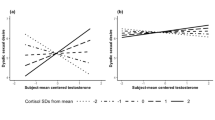Abstract
Eleven couples, ages 21–31 years and married for at least 1 year, were studied intensively over a three menstrual cycle period from both an endocrine and a sexual behavior standpoint. Each subject was interviewed individually and had a blood sample drawn twice weekly. Interviews were rated independently by two psychiatrists for degree of sexual initiation, responsivity, avoidance, couple interaction, and mood. Wives rated themselves also for degree of sexual gratification (responsivity). Plasma levels of testosterone and cortisol were determined for both husbands and wives while progesterone and estradiol levels were determined additionally for wives. Husbands' initiation scores were significantly correlated with their wives responsivity (clinically rated) scores for 10 of the 11 couples; wives' initiation scores were significantly related to their husbands' responsivity scores for 8 of the 11 couples. When either set of correlation coefficients was treated as a new variable and intercorrelated with the husbands' average testosterone levels, a significant relationship was obtained. Intercourse frequency, while not related to either partner's average testosterone levels, was related to wives' testosterone levels at their ovulatory peaks. The wives' self-rated gratification scores correlated significantly with their own plasma testosterone levels. Inspection of each wife's plasma testosterone profile across the three cycles indicated that a dichotomy occurred, with some women showing a high baseline level and others showing a low baseline level. When wives were dichotomized on this basis, it was found that high baseline testosterone level was significantly related to high self-rated gratification score and to ability to form good interpersonal relationships.
Similar content being viewed by others
References
Abraham, G. E. (1974). Ovarian and adrenal contribution to peripheral androgens during the menstrual cycle.J. Clin. Endocrinol. Metab. 39: 340.
Abraham, G. E., and Chakmakjian, Z. H. (1973). Serum steroid levels during the menstrual cycle in a bilaterally adrenalectomized woman.J. Clin. Endocrinol. Metab. 37: 581.
Benedek, T., and Rubinstein, B. (1942).The Sexual Cycle in Women: The Relation Between Ovarian Function and Psychodynamic Processes National Research Council, Washington, D.C.
Chandler, D., Seegan, G., and Mayes, D. (1972). Unpublished manuscript, Endocrine Sciences.
Doering, C. H., Kramer, H. C., Brodie, H. K. H., and Hamburg, D. A. (1975). A cycle of plasma testosterone in the human male.J. Clin. Endocrinol. Metab. 40: 492.
Fisher, S. (1973).The Female Orgasm Basic Books, New York.
Furuyama, S., and Nugent, C. A. (1971). A radioimmunoassay for plasma progesterone.Steroids 17: 663.
Furuyama, S., Mayes, D., and Nugent, C. A., (1970). Radioimmunoassay for plasma testosterone.Steroids 16: 415.
Judd, H. L., and Yen, S. S. C. (1973). Serum androstenedione and testosterone levels during the menstrual cycle.J. Clin. Endocrinol. Metab. 36: 475.
Persky, H., O'Brien, C. P. and Khan, M. A. (1976). Reproductive hormone levels, sexual activity and moods during the menstrual cycle.Psychosom. Med. 38: 62.
Persky, H., Lief, H. I., O'Brien, C. P., Strauss, D., and Miller, W. (1977). Reproductive hormone levels and sexual behaviors of young couples during the menstrual cycle. In Gemme, R., and Wheeler, C. C. (eds.),Progress in Sexology Plenum, New York.
Smals, A. G. H., Kloppenborg, P. W. C., and Benraad, T. J. (1976). Circannual cycle in plasma testosterone levels in man.J. Clin. Endocrinol. Metab. 42: 979.
Spitzer, R. L. (1977). (Chairman, APA Task Force on Nomenclature and Statistics),DSM III Field Manual, New York.
Waxenberg, S. E., Drellich, M. G., and Sutherland, A. M. (1959). The role of hormones in human behavior. I. Changes in female sexuality after adrenalectomy.J. Clin. Endocrinol. Metab. 19: 193.
West, C. D., Damast, B. L., Sarro, S. D., and Pearson, O. H. (1956). Conversion of testosterone to estrogens in castrated, adrenalectomized human females.J. Biol. Chem. 218: 409.
Willson, R. J., Beecham, C. T., and Carrington, E. R. (1975).Obstetrics and Gynecology Mosby, St. Louis.
Wu, C., and Lundy, L. (1971). Radioimmunoassay of plasma estrogens.Steroids 18: 91.
Author information
Authors and Affiliations
Additional information
This study was supported in part by Grant No. MH 21044 from the National Institute of Mental Health, U. S. Public Health Service. H. P. is the recipient of a research scientist award, Grant No. MH 18374, from the National Institute of Mental Health, U. S. Public Health Service.
Rights and permissions
About this article
Cite this article
Persky, H., Lief, H.I., Strauss, D. et al. Plasma testosterone level and sexual behavior of couples. Arch Sex Behav 7, 157–173 (1978). https://doi.org/10.1007/BF01542376
Issue Date:
DOI: https://doi.org/10.1007/BF01542376




